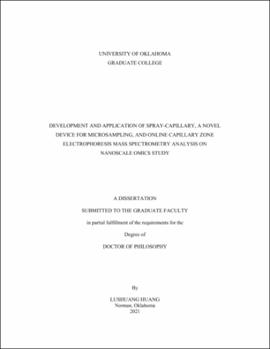| dc.description.abstract | The capillary zone electrophoresis-mass spectrometry (CZE-MS) platform, a well-developed analytical methodology, has been widely used for high-throughput nanoscale (e.g., < 5000 cells, single-cell sample) bioanalysis (e.g., proteomics and metabolomics). The sample size for a nanoscale study can be extremely limited in both volume (e.g., pL-nL) and amount (e.g., ng). Therefore, it is valuable to construct a high-throughput, user-friendly, and ultrasensitive CZE-MS platform for nanoscale analysis. This dissertation focuses on developing a novel quantitative sample handling device for ultralow-volume samples (e.g., pL-nL) and applying it for the online CZE-MS analysis of single cell samples.
Firstly, a novel sample handling device, spray-capillary, was developed for quantitatively extracting pL-nL level samples (e.g., as low as 15 pL/s). Electrospray ionization (ESI) is an ionization approach that has been routinely applied to couple liquid phase separation with MS detection but not for sample handling. The spray-capillary device is constructed from a commercially available fused silica capillary with one end being treated as the sample inlet and the opposing end being treated as an MS end. The MS end will be fabricated to a sheathless interface for electrospray-assisted sampling handling. Our results show that a low-volume sample (e.g., pL range) can be quantitatively introduced into a bare capillary for a pressure-based elution and MS detection. In addition, the spray-capillary can serve as the CZE separation column for on-capillary CEZ-MS analysis, which largely reduced sample loss from the offline sample handling process. A standard peptides mixture was used for prove-of-concept for the quantitative nanoscale CZE-MS analysis. The sample loading process is reproducible and adjustable.
Secondly, the original spray-capillary setup is manually operated, which makes the workflow low-throughput and prone to human error. Also, the usage of a bare capillary limits the performance of CZE-MS analysis (e.g., sample loss due to the adsorption on the capillary). To address these issues, we incorporated a commercially available CZE autosampler to perform fully automated spray-capillary analysis and utilized polyethylenimine (PEI) as capillary coating material to increase the separation efficiency.
Thirdly, we redesigned the original spray-capillary device to perform the single-cell metabolomics analysis. The sample inlet end was laser pulled to a small tip (i.e., 15 µm o.d.) so it can be directly inserted into single onion cells for ultra-low volume microsampling. The extracted single-cell contents can be directly separated and analyzed in the modified spray-capillary using the online CZE-MS analysis, which significantly decreases sample loss by eliminating off-line sample handling processes. Spray-capillary-based direct infusion single-cell analysis identified 80 cross-verified onion metabolites, while spray-capillary–based CZE-MS single-cell analysis identified 160 cross-verified onion metabolites. Additional experiments include a relative migration time comparison with standard chemicals, and targeted MS/MS analysis were performed to confirm the identification of the metabolites.
Overall, this work has demonstrated that spray-capillary provides a valuable solution for nanoscale microsampling and high-throughput omics analysis using the on-capillary CZE-MS analysis (e.g., single-cell analysis). The spray-capillary approach holds great potential for being incorporated into a variety of CZE-MS-based nanoscale analysis workflows for multi-omics study. | en_US |
